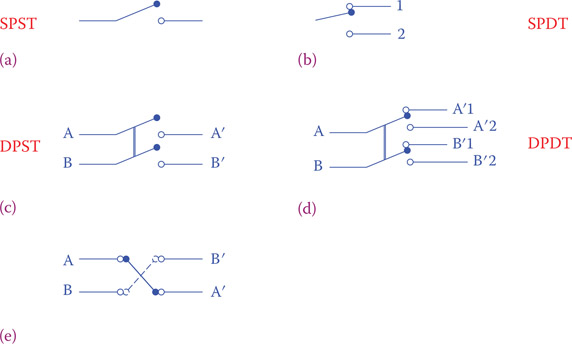Appendix B: Switches
A switch is a principal element in any device or circuit because we need to have a control to turn a device on and off. Like any other component, to be used in a circuit, a switch must be rated for the circuit. For example, in buildings in North America, most of the switches that are used for lighting are 15 A and good for 120 V. Thus, for the circuit of a dryer, for instance, which takes more current than the other appliances, such a switch should not be used.
In addition to the ordinary switches you are more familiar with, there are other switches that you should know about. The ordinary switch has two terminals and has two states: on and off. Thus, its function is to connect or disconnect the two terminals. This type of switch is called single-pole single throw (SPST) switch.
A single-pole double throw (SPDT) switch is a type of switch that has three terminals. By toggling the switch, one terminal alters connection between the other two terminals (see Figure B.1b). Thus, with this switch, one line connected to the main or common terminal is connected either to terminal 1 or to terminal 2 (but not both at the same time). If one of the terminals is not used, then this switch can function as a SPST.
In a single throw of a switch it is possible to simultaneously connect two independent pairs of lines. This switch is called double-pole single throw (DPST). Its schematic is shown in Figure B.1c. Such a switch acts as two simultaneous single-pole single throw switches.
By combining two single-pole double throw switches, a double-pole double throw (DPDT) switch is obtained. This switch has six terminals. By one action, two separate terminals are independently connected either to position 1 or to position 2, as shown in Figure B.1d.
There is also another switch as shown in Figure B.1e. This rotary switch has four terminals. By turning the switch knob, either A is connected to A′ or B is connected to B′. This switch can be used in conjunction with two SPDT switches when a device must be turned on from multiple points. For instance, for a stairway light (accessed from two points) a pair of SPDT switches are employed. To add a third, fourth, etc., point of action, this type of switch must be added in between the SPDTs.
In smaller-scale switches for low current, particularly for electronic circuits, you can find sliding switches that function as a DPDT, but with more terminals; for instance, there are five pairs of terminals, A through E and A′ through E′. When in the off position, no terminals are connected to each other, but in the on position, A is connected to A′, B′ is connected to B, and so on.

Figure B.1 Schematics of various switches. (a) Single-pole single throw. (b) Single-pole double throw. (c) Double-pole single throw. (d) Double-pole double throw. (e) Double-cross switch.
